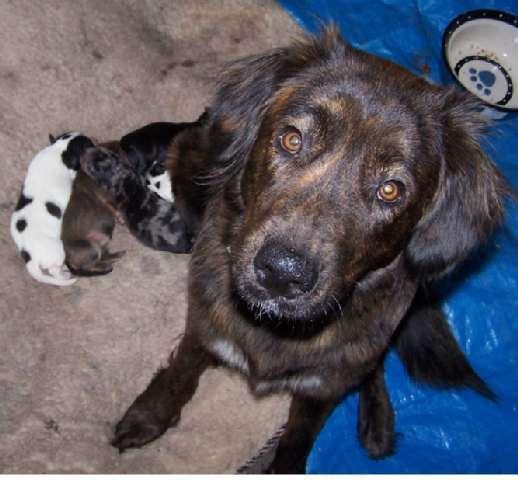Kathy Lynn Emerson's Blog, page 58
November 27, 2016
50 Writers Offer Advice to the Newly Published
Kate Flora: When I asked my Facebook friends for advice for newly published writers, my lovely friend Patricia Smiley immediately offered this advice: If it’s not too late…RUN, RUN AWAY!
But if you’re not inclined to run? Here’s a little of my advice, followed by advice from dozens of experienced writers. Never leave home without a case of your books in the trunk. Seriously. Not just for your first book, but for EVERY book. In the midst of events, promotion, and writing the second book, take the time to celebrate the joy of publication, There is never again a moment like the arrival of the first book. And of course, there’s be nice to people. We’re a small community. Much of this is echoed in the comments below.
On the Importance of Celebration and Balance, or Enjoy the Moment and KEEP WRITING
Steven Axelrod: Lower your expectations, and get that next book written.
Linda Gordon Hengerer: Keep writing. Don’t let the process stop the next book.
Lisa Alber: You only get one debut novel experience — remember to enjoy the ride!
Janet Schnell Koch: Don’t read reviews. The bad ones will depress you and you won’t believe the good ones.
Michael Broadway: Now that you have one published, it’s time to start writing the next one.
Joyce Yarrow: Relax and rejuvenate – read the books you didn’t have time to read while writing – and then get back to work. If your publisher did not send out ARC’s, mail a few out to reviewers and set up a few readings/signings at bookstores. Don’t try to master marketing techniques unless that’s your chosen field – remember – you are a writer!
Wendy Hornsby: Keep writing.
Ellen Byron: Enjoy every minute of it. There’s only one first time.
Carl Johnson: I would give three pieces of advice, ENJOY! ENJOY! ENJOY! It will never better than your first event but they’ll all be fun if you let yourself relax and enjoy the people and take pleasure in the interest and the enjoyment they get from your book. Be seen as much as you can BUT don’t let the book, or books, become your life. The old saying ‘All work and no play, etc.’ applies to writers as much as anybody. If you become dull, your books will, too.
Marni Graff: Moderate your marketing work to allow WRITING time or you won’t have anything else to sell!
Daniel Palmer: My dad’s advice to the question of what next was always the same: write another book.
Nancy Myer: Never give up! Rejection letters are part of the process.
John DeDakis: Don’t give up
Wendy Mnookin: Take a deep breath, and write.
Rick Helms: Write. Submit. Repeat.
J.M. Cornwell: Good days, bad days, blah days, no matter what, keep writing. Writing improves when you write every day, and some days nothing good seems to end up on the page. Even so, don’t stop writing.
Ilene Schneider, Rabbi-Author: Grow a thick skin against criticism. But don’t get overly confident about success. Don’t expect to get rich.
Ray Salemi: Don’t let it get to you.
Steven Axelrod: Lower your expectations, and get that next book written.
Linda Gordon Hengerer: Keep writing. Don’t let the process stop the next book.
Ray Salemi: Quit your day job. Right now. Today.
Devon Ellington: This is just the start of the marathon. This is the last time you can take as long as you want to finish a book or use “life” as an excuse not to write.
Vaughn Hardacker and Ray Anderson say: Don’t quit your day job, while Ray Salemi says quit your job at once. Ray is joking. See Ilene’s comment, above.
Sheila Lowe: The only thing better than the arrival of the first book is the arrival of the second book :)
On the Business of Writing:
Reed Farrel Coleman: Getting published isn’t the end point, but the starting point. Figure out how to sustain the momentum.
Brendan DuBois: As much as it pains me to say this, don’t trust your editor, and keep pressure on your agent. It’s *your* career. Take responsibility for it. Don’t believe the promises and hype. Push to promote. And keep writing, writing, writing.
Lea Wait: Thank your agent and editor … and keep in touch. Let them know about your promotional schedule and send copies of any local articles/reviews they might not have seen.
Elizabeth Black: The money flows from the publisher to the writer, never the other way around. Never pay to have someone publish your work. Vanity presses and scams are out there so watch out for them. That said, it is always a good idea to hire a good editor to read your book or do a trade with another writer you respect for substantive editing and grammar/spelling editing. Editors see things you miss since you’re very close to your work.
Bonnie Riley: As a website support person, I would urge you to let your fans know what is going on, especially when and where you will be making appearances and the names of all your books (by series, if that applies) and in what order they might ideally be read.
Gale Borger: Congratulations, and your job has only begun. You are the one who needs to market. You may not get to be rich and famous, but that is not why we write in the first place. We are compelled. Keep this feeling of joy and accomplishment close to your heart, it is your reward. Never stop writing, and the mean people out there can piss up a rope.
Patricia Gulley: Don’t spend too much money on those 1 or 3 month Twitter blasts.
Robert Walker: Luck plays the largest role in publishing. Lightening strikes are rare, and while it happens, you can count on it as much as you can count on winning the lottery. As in any entertainment business, there are a few stars at the top and thousands of authors never make star status in the category they’ve chosen to write in. The best you can do is to write the best book you can after the disappointment sure to come with first publication when you learn your publicist has 300 books this month to ‘publicize’ and only two of these have a budget as they are books by the stars already successful. This sounds pessimistic but I am obviously an optimist since I am working on my 67th title regardless of status and rewards and remuneration.
On modesty, humility, and the crime writing community:
Susanna Calkins: Don’t shut the door behind you. GIVE BACK to the writing community.
Dru Ann: Be kind to all readers – even if they may not read your book
Mysti Berry: You’ll spend about a year on a serious ego trip without realizing it. Very few writers escape this period. Try not to do too much damage until your ego deflates again.
Michelle Hoover: Keep your humility. You aren’t saving the world, but hopefully you’ve written a great damn book.
Sue Ann Jaffarian: Don’t be an arrogant ass. Yes, your book got published, but this is a long game and you need to develop relationships as well as sell books to stay in it.
On Promotion:
Bill Hopkins: Series sell, so write a series. And make yourself a facebook page.
Terry Shames; So much good advice. One more: Promote other writers whose work you admire. It gives you a chance to get your mind off your own success/failures, and gives you something to talk to readers about.
Les Roberts: When my debut novel appeared (in 1987), it had been named the very first winner of the “Best FIRST Private Eye Novel” contest. I got calls from the L.A. Times,m Los Angeles Magazine, The Washington Post, The N.Y. times and many others, for interviews, photos, etc. So when my second book came out one year later, I sat back and waited for all those publications to call again. I’m still waiting. I can count on my fingers the number of authors whose first books were BLOCKBUSTERS and have remained famous for 30 years or more, and I’d still have a few fingers left over. Writing the book is only HALF the job. The rest of it is marketing, promoting oneself. If you hate that part of the job, start learning to cheerily say “Did you want fries with that?”
Mary Feliz: Get all your promotional ducks in a row as early as possible, and write everything down so that you can do it again for Book 2. All purpose reply to any book feedback, positive or negative, is “Thank you so much!” Don’t feed the trolls. And (hopefully you’ve been doing this all along) GIVE BACK! And don’t be afraid to approach librarians and bookstores to find out how you can help them. Helping them helps you and it turns out they don’t eat authors for breakfast. People in libraries and bookstores actually tend to like books and authors. Fancy that!
Marylee MacDonald: Start an email list so that you can regularly stay in touch with readers. I like ConvertKit and GetResponse. They’re easier than AWeber ànd Mail chimp.
Ramona DeFelice Long: If you want to do public readings, think out of the box. We sold a lot of anthologies at museums and historical sites after readings.
Maureen Milliken: Don’t stop and rest on your laurels. Keep hustling and writing, because that first book wears off fast out there (unless it’s To Kill a Mockingbird)
Mary Harris: “Shameless Promotion for Brazen Hussies,” a Sisters in Crime publication available for $1.99 ebook version. Money well spent! Shameless Promotion for Brazen Hussies by Roberta Isleib, ed. (eBook) – Lulu
LULU.COM
Lori Avocato: Contact all kinds of clubs and libraries in your area to do a talk. If your book is about golf, contact the golf clubs. Also, carry business cards everywhere and leave them with your bill in a restaurant and tell everyone you meet that you are a published author–and say, “Here, let me give you one of my cards.” Don’t say “Do you want one!”
Ritter Ames: Spend as many hours per day marketing as you do writing, and that doesn’t mean spending all your marketing time on Facebook–LOL!
Peggy Northrop: A very smart author and PR genius (thank you Beth Feldman ) told me “Every book is a startup” and it’s so true. If your book isn’t getting attention from your publisher, it’s not unusual or personal. The most successful authors keep marketing, speaking, writing blog posts with links to their books, for years. Another friend finally had a bestseller after ten years of promotion. An audience rarely magically “finds” you — you have to introduce yourself.
November 25, 2016
Weekend Update: November 26-27, 2016
 Next week at Maine Crime Writers, there will be posts by Kate Flora (Monday) Maureen Milliken (Tuesday), John Clark (Wednesday), Kaitlyn Dunnett/Kathy Lynn Emerson (Thursday) and Bruce Coffin (Friday).
Next week at Maine Crime Writers, there will be posts by Kate Flora (Monday) Maureen Milliken (Tuesday), John Clark (Wednesday), Kaitlyn Dunnett/Kathy Lynn Emerson (Thursday) and Bruce Coffin (Friday).
In the news department, here’s what’s happening with some of us who blog regularly at Maine Crime Writers:
December 3, Lea Wait will be signing her books at the Unitarian Universalist Church Holiday Fair in Brunswick, Maine (across from the library) from 9 until 2. She’s also excited that her Shadows on a Morning in Maine is included on a list of Maine books on this month’s cover of Portland Magazine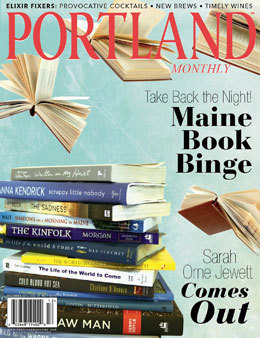 !
!
Saturday, December 3, Maureen Milliken and Jen Blood will be signing and selling books at the Belgrade Holiday Fair, 10 a.m.-3 p.m. The first book in Jen’s new Flint K-9 series, The Darkest Thread, was released in October.

The logo for Crime&Stuff, the podcast produced by Maureen and Rebecca Milliken that debuts next week.
Maureen, inspired by this year’s Crime Bake, has also given in to her sister Rebecca’s constant prodding and the two of them are producing a podcast focusing on crime, both in the news and in fiction. The first episode of Crime & Stuff drops next week and you can find it on iTunes or through the podcast’s website, Crimeandstuffonline.com, which should be up and running by Sunday. They also have a Facebook page, Crime & Stuff, and will be tweeting from @crimeandstuff. Feel free to like them on Facebook, follow them on Twitter and subscribe to the podcast.
They’re not professional broadcasters and not investigating or solving crimes, just taking a topic in the news or the mystery world each week, finding out as much as they can about it and running with it. They’d like to think it’s the podcast you’d do if you didn’t have better things to do. Check it out.
An invitation to readers of this blog: Do you have news relating to Maine, Crime, or Writing? We’d love to hear from you. Just comment below to share.
And a reminder: If your library, school, or organization is looking for a speaker, we are often available to talk about the writing process, research, where we get our ideas, and other mysteries of the business. Contact Kate Flora
November 24, 2016
Thanksgiving Leftovers: Corn and Turkey Chowder
Hi All. Barb here. I know you are absolutely bursting after yesterday, and perhaps nursing a tryptophan hangover, or a real one. Also, perhaps you are wondering what to do with the turkey carcass? So I decided to rerun a blog from two years ago for you–the one with my grandmother’s recipe for corn and turkey chowder.
++++

Thanksgiving Dinner–After
I hope yesterday you had a lovely day. We did. We spent the holiday at my husband’s sister’s house with most of my husband’s five siblings and spouses, along with assorted nieces, nephews, in-laws, outlaws and friends. It’s always a lovely day and the food, contributed by everyone, is delicious.
But I have to admit that my favorite part of Thanksgiving dinner is the leftovers. To wit:
Pie for breakfast: Pie, particularly apple or pumpkin, is the perfect breakfast food, a special treat after a holiday or other special occasion.

Desserts–Before
A turkey sandwich: I prefer mine cold, with mayo, stuffing, cranberry, and dark meat. On toasted white, or even better, scali bread. My husband cooks the “second turkey” for our celebration, and part of the reason to have one is to make sure everyone goes home with leftovers.
My grandmother’s Corn and Turkey Chowder: I grew up all my life with this dish. Initially, my father’s mother made it, then my mom took over, and now I do it.
This year, I thought we were out of luck, because my husband, a relentless experimenter, is doing a de-boned turkey. (You cook it over the stuffing, which gives the flavors of the turkey to the stuffing without the dangers of having it in the bird–at least allegedly.) So I’d written off the corn and turkey chowder. But my husband got to the butcher before they’d de-boned the bird, and was offered the carcass–so we’re back on.

Desserts–After
It’s a hearty soup, so chuck in plenty of turkey meat. However, as a child and into adulthood, I never, ever ate this meal without someone from one of the previous two generations saying, “When we made this during the Depression, there was never any meat left on the turkey bones. You kids don’t know how good you have it.”
They were right, of course. We probably don’t, but we certainly can appreciate how lucky we are to share this satisfying dish.
Here is the recipe, exactly as my mother wrote it down for me.
Corn and Turkey Chowder
Day One
Break turkey carcass into as small pieces as you can–include skin. Cover with water–two quarts will usually do it. Add a regular cooking onion with the skin on it, stuck with three or four cloves. Bring to a boil and simmer with lid partway on, an hour to an hour and a half. Pick out large pieces of carcass and strain the rest into a big bowl. Pick useable meat off the carcass and out of the strainer and add it to the broth in the bowl. Refrigerate overnight. Throw out bones.
Day Two
Remove fat from top of broth.
If only making for a few, divide broth and meat and freeze half for later use.
Put other half back in pot.
Add 1/3 to 1/2 bag of frozen chopped onions. Bring to a simmer.
Add
two cans of creamed corn
one can of niblet corn
one can of evaporated milk.
salt and pepper to taste.
You can use the remaining frozen turkey base to make turkey soup or you can make another batch of corn and turkey chowder later.
When making for a lot of people, use whole base, increase both kinds of corn, onion and evaporated milk. You sort of learn by doing. You want a substantial dish out of this. If you think you have too much broth, boil it down a little before adding the other ingredients.
Serve with a crusty bread.
Enjoy!
Save
Save
Save
Save
November 23, 2016
Would You Trust Food Cooked by a Crime Writer?
Happy Thanksgiving, friends. Today, all the writers have the day off. We’re in fine  kitchens everywhere, or carefully decanting the wine, or fighting about how a turkey should properly be carved, or we’re sharpening our knives or crimping crusts or just leaning back in our chairs, contemplating naps. Although Dorothy and Lea report they are both in book jail.
kitchens everywhere, or carefully decanting the wine, or fighting about how a turkey should properly be carved, or we’re sharpening our knives or crimping crusts or just leaning back in our chairs, contemplating naps. Although Dorothy and Lea report they are both in book jail.
At John and Kate’s house, on Thanksgiving, the women huddled in the kitchen, making the dinner, while the men put on their woolies, grabbed their guns, and headed out into the woods to seek the elusive deer. The separation of labor followed time-old traditions, until their feminist mother, weary of doing all the work, hatched a scheme that outraged poor Bob Clark and sent the aged relatives into a tizzy. She handed out numbered slips of paper to everyone, and the people paired by those numbers became the after-feast dishwasher and dryer until they were relieved by a subsequent team. The sight of curly-coiffed aunties and portly uncles, apron-swathed, taking their turns at the sink, was priceless.
We also had a family specialty called “Stolen Apple Pie” which is simply apple pie made from at least five varieties of apples gathered while driving along back roads looking for apple trees on abandoned farms or hanging over the road.
Just in case you’d trust our recipes, even if our cooking makes you nervous, here are some recipes from the writers:
Susan Vaughan: Perfect for Maine because it uses maple syrup
Pureed Yams
(Can be reduced or expanded easily)
3 yams or sweet potatoes, cooked, then peeled and cut into 3-inch pieces
4 tablespoons butter, cut up
1 tsp nutmeg
½ tsp cinnamon
Salt and pepper to taste
½ cup maple syrup (or less, to taste)
Sprinkle cooked and cut-up yams with spices, maple syrup and butter. Mash by hand or lightly in food processor until pureed, but take care not to overwork them.
Bake in 9 X 11″ dish at 375 for 15-20 minutes to heat. 6 servings
Kathy Lynn Emerson/Kaitlyn Dunnett: in my husband’s family, these are always made for dessert at Thanksgiving, along with the usual pies.
 OLD FASHIONED HOMEMADE WHOOPIE PIES
OLD FASHIONED HOMEMADE WHOOPIE PIES
Cream together 3/4 cup Crisco, 1 1/2 cup sugar, 1 large egg, 1 1/2 tsp. vanilla
Sift 3 cups flour, 2 1/4 tsp. baking soda, 3/4 tsp. salt, 1/2 cup plus 2 Tbsp cocoa
add dry ingredients to creamed mixture, alternating with 1 1/2 cup milk
drop on ungreased cookie sheet by Tbsp
bake at 350 for 20 minutes
Filling: 1 cup Crisco, 1 cup plus 2 Tbsp confectioner’s sugar, 1 tsp. vanilla, dash of salt, 6 rounded Tbsp marshmallow fluff (or one 7 oz. jar)
whip until light
Put filling between two “cookies” and enjoy!
Lea Wait’s Chocolate Sauce (for ice cream … angel cake …. or whatever!
(Technically, this is my grandmother’s recipe … but it is one I make often (probably too often) because my husband loves it.)
Melt 1/4 cup butter in sauce pan. Add 1/4 cup (1-1/2 squares) bitter chocolate shaved into very thin pieces. Heat over low heat until smooth — then add 1/4 cup cocoa (not instant — old fashioned!), 3/4 cup sugar, 1/2 cup light cream (or 1/4 cup heavy cream and 1/4 cup milk), pinch of salt, and 1 teaspoon vanilla. Bring to boil. Remove from heat. Chill. Reheat as necessary … makes about 1 pint.
Jessica Estevao/Jessie Crockett: It seems sweet potatoes are popular with Maine Crime Writers! Every year I make make my favorite recipe for sweet potatoes. I peel them and cut them into small pieces. I add them to large pot and cover them with sweet cider. I bring them to a boil and cook until tender. Drain them, mash them with a few chunks of butter. Add salt and pepper to taste. Delicious!
Brenda Buchanan: Apple pie and cheddar cheese. How can you beat that combo? Here’s an easy recipe for those (not me!) who are intimidated by the notion of making piecrust. This works for all kinds of events during the holiday season:
APPLE CHEDDAR CRISP
For the filling:
7 good pie apples (Cortland, Winesap, Granny Smith), peeled and sliced
1 tsp. salt
½ cup sugar
2 Tbsp. lemon juice
1 tsp. nutmeg
Jar of Orange-Cranberry marmalade (Stonewall Kitchen makes a great one. Pricey, but great.)
For the topping:
½ cup flour
1 cup quick oats
1 cup brown sugar
1 tsp. cinnamon
1 ½ cups shredded sharp Cheddar cheese (it saves time to buy pre-shredded)
1 cup cold butter
Preheat oven to 350°. Place all filling ingredients in a bowl and mix together, then transfer into a 9” x 13” baking pan or dish (glass or ceramic works best).
To make topping, put the flour, oats, sugar, cinnamon and cheese in a bowl and mix well. Cut in the butter and mix with your (clean!) hands until blended and crumbly.
Sprinkle the topping on the apples and bake for 45 minutes.
Serve warm. It can be topped with whipped cream or vanilla ice cream by those determined to gild the lily.
Barb Ross: One of the dishes I’ll be bringing to the feast this year are my grandmother’s yellow turnip. (Also called rutabaga.) You think you don’t like turnips, but you do.
YELLOW TURNIP
1 turnip (2-3 pounds), peeled, cut in chunks
1 large potato, peeled, cut in chunks
2 large onions, cut up
1 tsp salt
4 Tablespoons butter
1 Tablespoon flour
Sugar
Salt
Pepper
Boil turnip, potato, onions and salt until soft. (Approximately 40 minutes.) Save one cup of the boiled waters, drain the rest and mash the vegetables.
In a small frying pan, melt the butter, add the flour and, stirring continuously, add the turnip water. The mixture will thicken to create a roux.
Mix the roux thoroughly through the mashed turnips. Add sugar, salt and pepper to your taste.
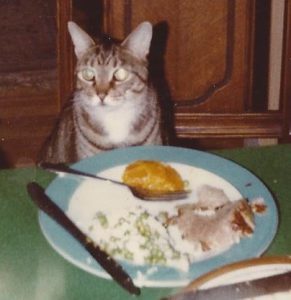
Our family cat, Mary Jane, joins the holiday table in 1981.
Maureen Milliken: I know everyone likes the traditional pies: apple, pumpkin, mince (shudder, actually I think my dad is the only one who eats that). But if you’re not already full from Brenda’s apple cheddar crisp, here’s a “pumpkin pie” recipe with an Italian twist: Pumpkin Ricotta Pie.
If you’ve never had ricotta pie, it’s a little like cheesecake, only different. Ricotta pie is a traditional Italian holiday treat, particularly at Easter, but I like to make it at Christmas, too, sometimes adding chocolate chips or other treats. But I digress. For Thanksgiving, it’s gotta be pumpkin.
This makes a fairly large pie, but if you cut it to four eggs and cut the ricotta by one-third, it’ll fit in a nine-inch pie pan. For the full recipe, use a 10-inch. I cheat and get a graham cracker crust. I know my Nonna would be rolling over in her grave, and the traditional pie crust is light, flaky and buttery, but it’s not when I make it, so I play it safe. And I might just try it with Lea’s chocolate sauce…
Here’s the recipe:
Preheat oven to 325.
6 eggs
1 cup sugar
1 tsp. vanilla extract
I 15-oz container of whole milk ricotta
Half a can of pumpkin filling
1/2 teaspoon cinnamon
1 10-inch graham cracker pie crust in pie tin (sorry Nonna)
1/3 cup brown sugar
Beat the eggs, white sugar, cinnamon and vanilla in a large mixing bowl.
Stir in the ricotta and pumpkin.
Pour the ricotta-pumpkin mixture into the pie crust. Bake at 325.
When it’s been in for about half an hour, sprinkle brown sugar on top (if the sugar is on top for too long, it will burn).
Bake a total of 50 minutes to 1 hour: a butter knife inserted into the center should come out clean.
Let cool before eating.
Mangia! (And Happy Thanksgiving!)
Save
Save
November 22, 2016
No Holiday for the Wicked
Dorothy Cannell: Happy Thanksgiving to one and all. I am, as so often happens at this 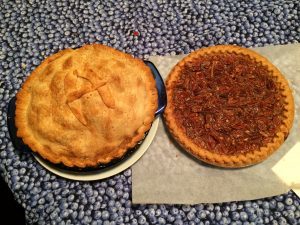 time of year, in book jail – a term coined by Kate Flora. It is where writers go when they have ignored looming deadlines until the panic stage kicks in. This being so, I won’t be cooking a lavish turkey dinner; my husband Julian and I will be eating out with friends at our favorite restaurant. I do intend, however, on giving a nod to the pilgrims by purchasing a pumpkin pie and making a pecan one. It is easy and a family favorite.
time of year, in book jail – a term coined by Kate Flora. It is where writers go when they have ignored looming deadlines until the panic stage kicks in. This being so, I won’t be cooking a lavish turkey dinner; my husband Julian and I will be eating out with friends at our favorite restaurant. I do intend, however, on giving a nod to the pilgrims by purchasing a pumpkin pie and making a pecan one. It is easy and a family favorite.
Southern Pecan Pie
Ingredients:
9-inch pie shell
4 eggs
1 cup sugar
1 cup light corn syrup
½ tablespoon flour
¼ teaspoon salt
1 teaspoon brandy (or vanilla extract)
¼ cup melted butter
2 cups pecan halves
Refrigerate 9-inch unbaked pie shell and Preheat oven to 350F
Make Filing in a medium bowl with a rotary beater, beat eggs well
Add the sugar, corn syrup, flour, salt and brandy, beat till well combined
Stir in butter and pecans, mixing well
Turn into unbaked pie shell. Bake 50 minutes, or until filling is set in the center
Cool the pie completely.
Serve with whipped cream. If desired add to the cream, 1 tablespoon sugar, grated peel of one orange, and two tablespoons brandy.

Where Dorothy is….
Now returning to my jail cell. Won’t have it to myself. I’ll have new puppy Watson tucked behind me on desk chair as I prod the keys. He’s an entire other blog, let me say only that I have renewed admiration for Sarah in the Bible who at age 800 hundred or something found herself running herself ragged on the arrival of baby Isaac.
Happy reading,
Dorothy
S. Julian had just informed me Sarah wasn’t nearly a thousand years old. Maybe not, but I’ll bet she felt like it by the time the little treasure turned one.
November 21, 2016
Setting and How It Affects Characters
Vaughn C. Hardacker here: This July my fourth thriller will be released by Skyhorse Publishing. The novel, WENDIGO, takes place entirely in the north Maine woods during the midwinter months of January and February. As I was writing the novel I soon realized that winter here in Maine’s northernmost county is as instrumental to the novel’s plot as the characters. In fact, the winter weather impacts all of my characters to a greater extent than they do one another.

Vaughn
Anyone who has ever experienced five feet of snow on the ground and more falling along with thirty miles per hour wind (with gusts of fifty miles per hour), minus 30 degree Fahrenheit temperature, and a resulting windchill of minus 67 degrees Fahrenheit (minus 73 degrees during the aforementioned gusts) can attest to the impact it has upon them. Normal activity as mundane as taking out the trash can quickly turn into a life and death situation. If you have either lived in or spent time in THE COUNTY any time from December to April you may have experienced these climatic conditions.
“How does this make setting become a character?” The one facet required to make a novel a success is the inter-relationships between the characters. It is easy to see how personal relationships affect people, now consider the extent that the above stated conditions do. Being out in these conditions has an obvious affect on our human characters and the risk of death from hypothermia is easy to see. Being cooped up inside a house or apartment for days on end will inevitably lead to cabin fever, which often culminates in arguments and, in extreme situations, murder. If there is any minor problem with a machine, i.e. a car/truck, a snowmobile, or even an aircraft, it could easily become a major issue. I have spent many a frigid day on my back lying on ice while changing a defective starter on a car. That same starter, in all probability would have functioned in warm weather.
It isn’t hard to understand all of the above. The WENDIGO is the physical manifestation of the most evil of Anisinaubae manitous . . . in short it’s one bad assed creature and a god as well! It’s powers are strongest during the long nights of winter and it is always hungry. In fact the more it grows and the more it grows the hungrier it becomes–it is in a perpetual state of  starvation. It has a restricted diet–lets suffice to say the menu could have been used by the Donner Party. The creature itself is horrifying enough, now the setting comes into place–the deep woods in midwinter. Put yourself into this situation: It’s 3:30 P. M. and you have been ice fishing on a remote lake and notice that the sun has set. You gather up your fish tip-ups, tackle, and other paraphernalia. Once you have packed everything into the trailer you have attached to your snowmobile, you settle onto the sled and turn the key–nothing happens. Immediately you realize that you left the ignition in the on position and the battery has been drained. In itself this is enough plot to drive the story, but think about the addition of the sudden appearance of a twenty foot tall, emaciated humanoid creature with teeth like a shark, emitting thunderous roars, and can run faster than any human. It doesn’t take a Rhodes Scholar to realize this thing ain’t there to help get your sled going.
starvation. It has a restricted diet–lets suffice to say the menu could have been used by the Donner Party. The creature itself is horrifying enough, now the setting comes into place–the deep woods in midwinter. Put yourself into this situation: It’s 3:30 P. M. and you have been ice fishing on a remote lake and notice that the sun has set. You gather up your fish tip-ups, tackle, and other paraphernalia. Once you have packed everything into the trailer you have attached to your snowmobile, you settle onto the sled and turn the key–nothing happens. Immediately you realize that you left the ignition in the on position and the battery has been drained. In itself this is enough plot to drive the story, but think about the addition of the sudden appearance of a twenty foot tall, emaciated humanoid creature with teeth like a shark, emitting thunderous roars, and can run faster than any human. It doesn’t take a Rhodes Scholar to realize this thing ain’t there to help get your sled going.
All of my books thus far have been set during the summer and early fall, WENDIGO is set during the coldest and darkest time of our year. The warmth of the holidays is behind us and the long tedious days of snow, more snow, yet more snow (in 2007 we got over 200″),  and below zero temperatures. If you work in a building and you don’t have a window in your workspace you’ll begin to feel like a mushroom, waking up before the sun, driving to work in the dark, and driving home in the dark. It is not unusual to go five days without ever seeing daylight–don’t even think about the sun as cloudy days are the norm. Truthfully, you don’t like sunny days . . . in January and February a sunny sky means high pressure. High pressure means COLD; on the other hand low pressure usually means SNOW and lots of it.
and below zero temperatures. If you work in a building and you don’t have a window in your workspace you’ll begin to feel like a mushroom, waking up before the sun, driving to work in the dark, and driving home in the dark. It is not unusual to go five days without ever seeing daylight–don’t even think about the sun as cloudy days are the norm. Truthfully, you don’t like sunny days . . . in January and February a sunny sky means high pressure. High pressure means COLD; on the other hand low pressure usually means SNOW and lots of it.
So how does all this apply to your characters? Winter is a time of short days, as illustrated above, and long cold nights when everything is shrouded in snow and ice. It’s not unusual for the banks alongside the plowed roads to be ten feet or higher–an ideal place for a villain or WENDIGO to lay in wait. The only sounds you hear as you walk along an unlit rural road is the crunch of your heavy boots on the frozen ground and the wind. Snow is blowing from the top of one snowbank to the top of the one opposite and your head and shoulders are covered. The atmosphere is claustrophobic as you feel as if you are walking in an ice tunnel. Suddenly the night is split with a booming voice that sounds like thunder and a twenty foot tall beast bounds over the snowbank and lands ten feet in front of you–did I mention that it smells like grave rot?
Don’t you think that would have an affect on your character?
Nuff said.
Remember This Day
“Remember this day.” That was Paul Doiron’s advice to me the day I received the very first paperback copies of my debut novel.
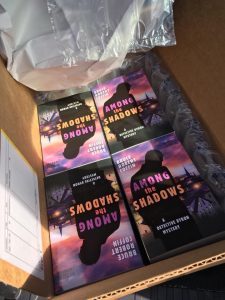 It was Saturday morning and the sun was shining and the temperature was nearing eighty as I loaded my pickup with trash, returnables, and a full recycling bin. It was getting close to eleven and I hadn’t really eaten anything you’d likely call breakfast. My plan was to hit the town dump then head back into North Windham to drop off the bottles and cans at Hannaford’s. After that I figured I’d swing by the post office, hoping for something other than bills, maybe even a bit of positive cash flow, before grabbing lunch at a fast food joint.
It was Saturday morning and the sun was shining and the temperature was nearing eighty as I loaded my pickup with trash, returnables, and a full recycling bin. It was getting close to eleven and I hadn’t really eaten anything you’d likely call breakfast. My plan was to hit the town dump then head back into North Windham to drop off the bottles and cans at Hannaford’s. After that I figured I’d swing by the post office, hoping for something other than bills, maybe even a bit of positive cash flow, before grabbing lunch at a fast food joint.
I held the door for a polite young woman then headed into the gloomy interior of the postal facility hoping for good news. Upon opening the box I discovered a new registration certificate for my wife’s car, a single piece of junk mail, and a yellow slip informing me that I needed to see the desk clerk for an item. Now I’ve seen these slips before. Usually deliveries are only kept at the counter when they’re either too big for the package bins or when all the bins are full. My mind raced. What could it be? Being early September, I surmised a pre-holiday fruitcake was probably out of the question. I hadn’t ordered anything recently and I couldn’t remember Karen telling me that she was waiting on anything. Although, maybe she had but I hadn’t been listening. Maybe she’d mentioned the purchase of some latest fashion, and instead of listening I’d glazed over like she does whenever I try and explain the inner workings of something mechanical, like the stereo remote. It was possible. The only thing I could imagine was the case of novels my publisher had promised to fulfill their contractual obligation. My pulse quickened. What was waiting for me behind the post office counter?
I dashed back to the lobby with my yellow card. Two clerks were working the counter, but the line was out to the door. My heart sank. What time does the North Windham Post Office close on Saturday? Damn. I couldn’t remember. Noon? That sounded right. I checked the time. 11:35. It was gonna be close. One by one I watched in horror as the two employees waited on my fellow Mainers. Each had a package or letters needing special handling, and wrapping, and weighing. And stamps! A collector was buying sheets. What the hell?
“Oops, hang on. That one needs another piece of packing tape,” a clerk said to one of the customers.
I was sure of it now. They were trying to kill me.
I checked my phone again. 11:40. OMG. I looked down and caught myself nervously tapping my right foot on the linoleum. I stopped.
“Yes, it has been a very dry summer, Mrs. Smith. How’s your garden?”
How’s her garden? Who cares? Jesus, if you’d just hurry up I’ll drive you to the grocery store myself and buy you all the vegetables you could ever want!
11:43.
I examined the yellow card in my hand. Read it again. I realized there was something familiar about it, this yellow card. Ah ha. I had it. The Yellow Card Man, from 11/22/63. Stephen King’s novel about the Kennedy assassination. My only hope was it didn’t foreshadow that I was about to step through some portal to the past, where I’d never find out what had been delivered.
11:46.
A customer finished at the counter and the line inched forward. I took one step. I thought again about the possibility of it being my novel. Was that even likely? I’d been in constant contact with both my editor and my publicist all week, and neither mentioned anything about the books being ready. Wouldn’t they have known? Of course they would. Maybe it wasn’t the books after all. Maybe I was being silly. How long does fruitcake keep? I looked down at my foot again. It was moving a little. I willed it to stop.
11:50.
Another satisfied customer peeled off and walked past me. One of the clerks looked at her watch.
Oh, no you don’t, I thought. Nobody leaves until I get my package.
The next customer shuffled up to the counter in slow motion.
I was due to be next. I glanced left and right, watching each transaction closely. Who would finish with their customer first? The male clerk on my left or the female on my right? People read left to right. I was betting on left. Come on, come on.
11:55.
I was beginning to feel a little like Oswald.
Finally, the customer at the window on my left was done and the male clerk waved me forward. Hot damn! I was working hard to hide my angst.
“May I help you?” the clerk asked.
“Yes,” I said, my voice cracking. “I received this slip in my mailbox.”
He took the slip from me. “What number?”
“What?” I said.
“Your box number. What is it?”
I couldn’t remember! I’d just emptied it and now I couldn’t remember the number!
I stared at the clerk. He stared back. What the hell? I couldn’t leave the line to go look. There were people behind me. They’d close before I ever made it back to the counter. I looked down at what I was holding in my hand. Mail. Ha! Correspondence from the state that had my address on it!
I recited my box number to him, fighting to stay calm. He repeated it back then walked out of sight. If this turned out to be clothes for my wife or a fruitcake, I’d be tying one on. Without question, the Yellow Card Man had reached his limit.
I watched in astonishment as the clerk rounded the corner with a large nondescript cardboard box. He had it on his hip and was struggling a bit with it’s weight. It certainly wasn’t a fruitcake. Too big for that. And clothes wouldn’t have been nearly as heavy.
Remain calm.
I watched him set the box atop the counter. A piece of paper was taped to the backside, but I couldn’t see what it said. I lowered my voice an octave trying to project cool. “Does it say who it’s from?”
He bent down to look. “Um, says it’s from HarperCollins, the publisher.”
My publisher! It was my books! Hallelujah!
“Man, I’ve been waiting for that,” I heard myself say from outside of my body.
I heard murmuring from the line behind me. Most likely someone thinking about driving me to the local bookstore to buy me some books if I’d only get moving.
“What is it?” the clerk asked.
I dropped yet another octave, moving from cool to nonchalant. “Oh, it’s just a bunch of copies of my debut novel, Among the Shadows.”
“What’s it about?” he inquired.
More murmuring.
“It’s a mystery,” I said. Smiling proudly, I lifted the box and headed for the door.
November 18, 2016
Weekend Update: November 19-20, 2016
 Next week at Maine Crime Writers, there will be posts by Bruce Coffin (Monday) Vaughn Hardacker (Tuesday), Dorothy Cannell (Wednesday), and Barb Ross (Friday), with a special Thanksgiving Day post on Thursday.
Next week at Maine Crime Writers, there will be posts by Bruce Coffin (Monday) Vaughn Hardacker (Tuesday), Dorothy Cannell (Wednesday), and Barb Ross (Friday), with a special Thanksgiving Day post on Thursday.
In the news department, here’s what’s happening with some of us who blog regularly at Maine Crime Writers:
 From Kaitlyn Dunnett/Kathy Lynn Emerson: The new Level Best anthology of New England Crime Stories, Windward, is now available as a paperback and as an ebook. It has short stories by me, my husband, and Kate Flora, among other New England writers.
From Kaitlyn Dunnett/Kathy Lynn Emerson: The new Level Best anthology of New England Crime Stories, Windward, is now available as a paperback and as an ebook. It has short stories by me, my husband, and Kate Flora, among other New England writers.
From Kate Flora: This coming Monday, Nov. 21st at 6:00 p.m., Bruce Coffin and I will be at the Kennebunk Library talking about our new police procedurals. The conversation between a seasoned cop who writes cops and a seasoned writer who writes cops should be pretty interesting. Hope we’ll see some of you there.
Coming this Thursday: A collection of recipes and stories about how real crime writers celebrate Thanksgiving.
And a reminder: This month’s MCW giveaway is Tea with the Authors, a collection of goodies to brew, goodies to eat, and goodies to read. Leave a comment on one of our posts to be eligible.
An invitation to readers of this blog: Do you have news relating to Maine, Crime, or Writing? We’d love to hear from you. Just comment below to share.
And a reminder: If your library, school, or organization is looking for a speaker, we are often available to talk about the writing process, research, where we get our ideas, and other mysteries of the business. Contact Kate Flora
The Best Medicine
Jessie: Feeling pensive.
Recently, I attended the New England Crime Bake. Every time I am in the midst of a group of writers it, not surprisingly, makes me think about what started it all in the first place. I’m not sure if all writers can pinpoint when they decided that writing was something they wished to pursue but I know exactly when I realised that I wanted to create stories to share with others.
When I was six years old I needed an emergency appendectomy. It was touch and go for a while as the toxins had spread round my system a bit. The surgeon told my parents it would be at least five days before they’d be sure I would survive. My mother was worried enough about the outcome that she slept in the hospital with me every night. She always read to me at bedtime at home and the hospital stay was no exception.
I had received a boxed set of Roald Dahl books for Christmas only a few weeks before but had not yet started to read them. My mother brought Charlie and the Chocolate Factory to the hospital and began to reading it to me. My mother is a delightful reader and snuggled up in a hopstical bed under a flickering, humming fluorescent light I was able to imagine myself swept away to a much more magical place. I was enchanted by the story and tickled pink by the humor.
By the time Violet Beauregarde was rolled off to the juicing room I laughed so hard I had ripped out most of my surgical staples. But somehow, it was worth it. Laughter really was the best medicine. By the fifth day I left the hospital, well on my way to a full recovery. I am convinced that the book and the pleasure it brought, the feeling it created that life was indeed magical, full of possibilities and not worth giving up helped move me out of the danger zone.
My health recovered but I never got over my attachment to Roald Dahl. Or books with humor and magic and well-deserved comeuppances. I knew from that point on that what I really wanted to do was to write stories of my own.
Readers, do you have a book that helped you through a difficult period? Writers, can you pinpoint when you decided on your life’s passion?
November 16, 2016
An Animal Rescue Story
Given the charged political climate and the fact that I’m still not quite recovered from the post-election catatonia I was plunged into after last Tuesday, I thought this month a little change of pace might be in order. As anyone who reads this blog has no doubt gathered by now, I’m very fond of the four-leggeds who walk among us — particularly my dog Killian, who will turn ten next month. I was running an animal rescue in Oregon when Killy’s mom arrived, very pregnant, and I’ve had the boy ever since. The following is a story I wrote for my nieces, about the unique circumstances surrounding Killian and his sister Adia’s birth and first year. Adia has sadly passed on since we wrote this, but I love the fact that her strident little voice lives on in this piece. I hope you enjoy!
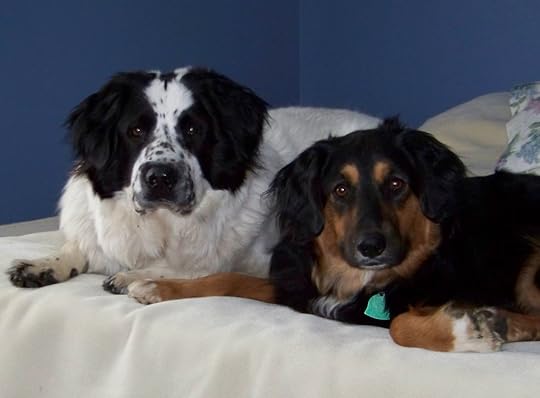
Killian and Adia
“It all began on a cold day in December, when Mama was in Oregon – ” Adia begins.
“That’s not how it started,” Killian interrupts. Killian is the bigger of my two pups, but he is not the most vocal. His brow is furrowed with concern; Killian likes things to be exact.
We’re settled in the living room to tell this tale, and naturally Adia – being the more extroverted (“you mean she’s a blabbermouth,” interjects Killian, at which point a brief skirmish breaks out) of the two has decided to kick things off.
“It did so start there,” snaps Adia. “Just let me tell it.”
“It started in California,” whispers Killian to me. I nod. He has a point.
“We weren’t even born when California happened,” Adie says. “How can I tell a story we weren’t there for?”
“Mama says our dog-ma came from California,” Killian says. He sits up, becomes very serious, and begins. “Our dog-mama, Rainne, was a stray dog in the city of San Francisco. She came to the Oregon farm in a van, and she was sick with coughing and if Mama and the other rescue people hadn’t sent for her, she would’ve been killed.”
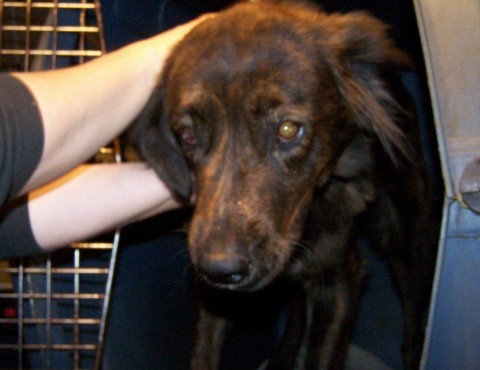
Rainne’s arrival at the rescue
“And we would’ve died, too,” says Adie. Clearly, she has come to agree that this is a better place to begin the story.
“Mama Rainne came to the rescue in Oregon with thirty other dogs,” Killian continues, “so it was very loud and crowded and scary. Those other dogs were all going to other rescues, so they could get adopted into nice homes. But our people mama met Rainney and heard her coughing, and she said,” Killy looks to me with baleful brown eyes, “What did you say, Mama?”
“She said, ‘There’s something special about this girl – let’s keep her here, just ‘til she feels better,” Adie interrupts excitedly.
Killian nods. “Yeah. That’s what Mama said.”
“But she didn’t even know we were in Mama-Rainne’s belly yet, because Rainney was so skinny. And then, we almost didn’t make it anyway, because Mama’s friend Dave took Rainney to the vet to get her fixed. And they would’ve done it – ”
“Even with babies in her belly, right, Mama?” Killian says.
“Sometimes that’s what has to be done. And that’s how it would have happened that day,” I agree gently.
“But Rainney was coughing too much, so the vet said he couldn’t do it that day. And then it was another two weeks before they could get another appointment,” Adie says.
“And by then it was too late!” Killian adds.
“And that’s when we were born,” Adia finishes triumphantly.
“Would you like to tell that story?” I ask Adia, who nods seriously (she’s never shy to tell a story) and settles on her dog bed with her paws crossed delicately in front of her.
“Then,” she says, “We got born, on a cold day in December when Mama was just getting over the flu, and she had a flight to Maine later that day for the holidays – ”
“And there was a sixteen-foot Christmas tree lodged in the front door!” Killian interrupts.
“I was getting to that part!” Adie says. “Tell him to stop interrupting.”
“There’s plenty of story for both of you,” I say. “Why don’t you tell about the day you were born, Adie, and Killy can tell us the next story.”
Adia nods her approval of this plan, and Killy sighs. He circles twice, lies down, and rests his chin heavily on his paws as Adia continues.
“Anyway,” she says, “there was a sixteen-foot Christmas tree lodged in the front door, ‘cause Dave wanted to get the biggest tree he could find, but it wouldn’t fit through the door! And Mama got up that morning to take a bath and Mama Rainne was staying in a kennel in Mama’s office in the next room, ‘cause they knew we would be coming any day. So, Mama was soaking in the tub when – ”
“She heard us crying!” Killy interrupts, his tail swishing with excitement.
“That was the best part!” Adie snaps. Then there’s another tussle that I have to break up, before each hound re-settles on their respective pillows.
“Now, where was I?” Adia asks.
“We just got borned,” Killian says.
Adie rolls her eyes at me, and continues. “Right, we were born,” she corrects Killian, “And it was Killy and me and our sisters Hannah and Tally, and our brother Connor.”
“Only we didn’t have any names yet,” Killy says.
“No,” Adia agrees. “We didn’t have any names, and we couldn’t walk, and we couldn’t even open our eyes, because we were such tiny babies. I was the littlest, and Killian was the biggest. And then, just when all five of us were born, Mama had to leave so she wouldn’t miss her plane. So, she kissed all five of our baby heads, and she kissed Mama Rainne, and said, ‘Good job, Rainney Girl. You rest now. I’ll be back in two weeks, to help you with these guys.’ And then she left.”
“We don’t remember much of what happened after that,” Killian says.
“Because we were too little,” Adie adds. “But Dave and Pop – that was Dave’s dad – pulled the tree in the front door with a whole lot of work, and they set it up in the living room and decorated it with dog toys, ‘cause there was so many of us. We ate and slept, mostly, until Mama came home.”

Pop, with the infamous 16-foot Christmas tree
“Then we opened our eyes,” Killian says. “But we waited ‘til we heard Mama’s voice. And the first thing we saw when we opened them was our people-mama, holding us.”
“That’s the first thing you saw,” Adie corrects him. “The first thing I saw was Tally, chewing on my ears. But you were in Mama’s arms the day you opened your eyes. And that’s why you’re still such a baby man when it comes to Mama.”
“I’m not a baby man,” Killy says indignantly. “I just know the people I love, and I don’t love the people I don’t know. Besides,” he lowers his voice, looking at me with an all-knowing dogged glint, “Me and Mama have a special bond. She knew I was hers, from the very start.”
It’s true, actually, that I knew from the start that Killian and I belonged together. For one thing, he cried copiously whenever I was away from him, but would settle down the moment I picked him up. There was just an energy that came from Killy, even as a pup, that spoke to me.
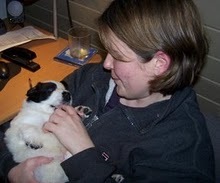
Me with Killian, at 4 weeks
“What about me?” Adie demands. “Didn’t I speak to you?”
“You never stopped speaking,” Killy says. Before another fight erupts, I interrupt.
“You were too busy causing trouble and fighting with your brothers and sisters to waste too much time on me in those early days,” I tell her.

Adie striding through the world, at 6 weeks.
“’Cause you were a troublemaker from the start,” Killian says.
“There was a lot of trouble to get into, though,” Adia says, rather than arguing the point. “There were goats and cows and cats and llamas and chickens and rats and… Who wouldn’t get in trouble, with all that? On our very first walk around the house, we learned all the crazy things going on in our world. Before that, we’d just been safe and secure in our kennel in Mama’s office. But then, we started meeting our pack.”
“It was a really big pack,” Killian says.
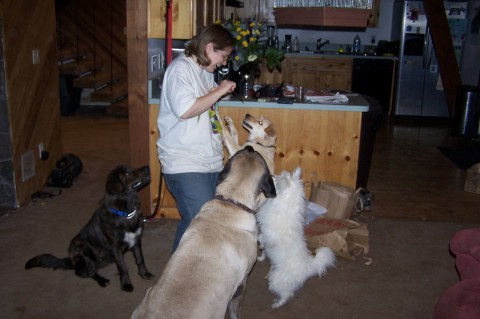
Training time, with Donna, Snowball, Spoon, and Rainne.
Adia agrees. “At first, Mama and Dave were careful about who they introduced us to, ‘cause some of the animals there didn’t like puppies so much. We met Grandma Spoon first – ”
“We loved Grandma Spoon,” Killian says, his eyes taking on a distant cast.
“We did,” Adie says. “Grandma Spoon was an English – ” she looks at me and whispers, “What was she, Mama?”
“Spoony was a prize-winning English mastiff who had been a gift to Dave,” I say.
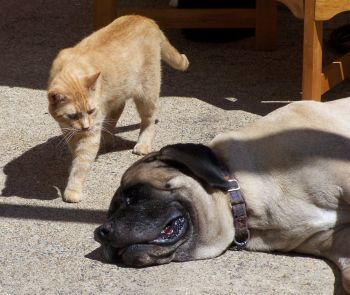
Marmalade the Cat checks out a snoozing Spoon.
“Yeah,” Adie says. “That. She’d been a mama before, so she knew just what to do to keep puppies in line. Everybody loved her – even kittens. She taught Rainney to be a good mom, since Mama says Rainney was practically a puppy herself.”
“Then we met all our aunts and uncles,” Killian says. “Buck and Linus and Cheesecake and Tiger.”
“And Donna,” says Adia. “And Louie!”
“Some of them were afraid of us – especially Louie,” Killian says. “Even though he looked big and tough, he was gentle as a kitten. Me and Adie and the other pups would chase him and chase him, and he would just hide. Then when he laid down, we’d find him and cuddle up next to him like he was our mama.”

King Louie
“And we met the goats, too,” Killian continues. “We’d have picnics with the goats.”
“On the farm,” Adie explains, “There was a house for the people and for the dogs, and there was a barn, and there was a cat house.”
“And lots of land,” Killian adds. “Tell them how much land there was, Mama.”
The farm was set on sixteen acres in Estacada, Oregon – about thirty miles outside Portland. We had a pasture and barn for the farm animals, and a three thousand-square-foot home that Dave and I shared with his eighty-five-year-old father and about twenty dogs, four degus, a parakeet, a Moluccan cockatiel, and a bathroom full of kittens. The cat house was a huge garage that held about thirty rescued cats, most of whom had come from a high-kill shelter down in California.
“It was a lot of space,” Adie concludes. “And once we were big enough, Mama and Dave would take us on picnics. They’d carry all five of us pups out into the field with some lunch and we’d play in the Oregon sunshine, and wrestle with each other, and explore.”
“And sometimes Butterfly the goat would come and say hello,” Killian says. “She was an old lady goat, and she loved to nuzzle Mama and chase after us pups.”

Tally vs Butterfly
“We loved our picnics,” Adie says.
“Except for one day, when the dinosaur tried to get us,” Killian says. “That wasn’t a very fun picnic.”
“She wasn’t really a dinosaur, though,” Adie says. “And she didn’t mean any harm – right, Mama?”
I shake my head.
Lucy just looked like a dinosaur, but in fact she was an ancient, tumor-ridden bulldog/Sharpe mix that Dave had rescued from euthanasia in a shelter back in California. She’d been a breeder for years, until she couldn’t handle another batch of pups – at which point, she’d literally been tossed out of a moving car, not far from the Merced County shelter. Dave brought her home and entrusted her care to Pop.
The old girl was too decrepit to move much, but she always got a spark under her when she smelled babies that she thought might be in need of mothering.
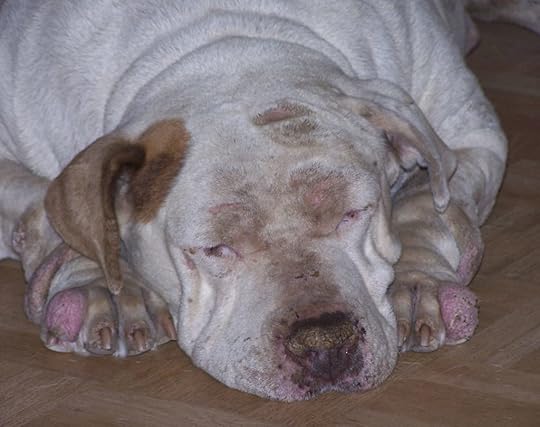
Lucy
“That day when we were out in the field,” Adie picks up the story, “Old Lucy hadn’t been farther than a few feet from the house in months. But when she heard puppies crying, she came plodding out to the field to find us.”
“Mama got real upset,” Killian says. “By that time, Rainney’d had enough of us, and so she wasn’t around much – we only had our people-ma to take care of us. She said, ‘Go on home, Lucy – these pups already have a mama.’ And she picked us up and moved us farther into the field. But pretty soon, along came Lucy, plodding along to try and rescue us. She got Tally in her mouth and started to carry her back to the house, and Mama had to go and save her.”
“Tally cried and cried,” Adie says. “She was awfully scared of Lucy.”
Not everyone was scared of Lucy, though. We started out keeping a parcel of sick kittens in the bathroom adjacent to Dave and my bedroom. When it became apparent that it wasn’t wise to have wild kittens at large in the middle of the night when one needed to use the facilities, we transferred them to a room that Dave painted a vibrant violet. We added a Buddha, a mattress, some plants, and a fountain. Dave called it our Tranquility Room – the perfect spot for kittens to grow into cats. Unfortunately, Spoony decided that the mattress in the Tranquility Room was the perfect spot for her, and the fountain ideal to slake the thirst of a hundred-and-fifty-pound English mastiff. She would periodically nose her way into the room – which wouldn’t have been a problem, had we not shared the house with several not-so-kitten-friendly dogs.
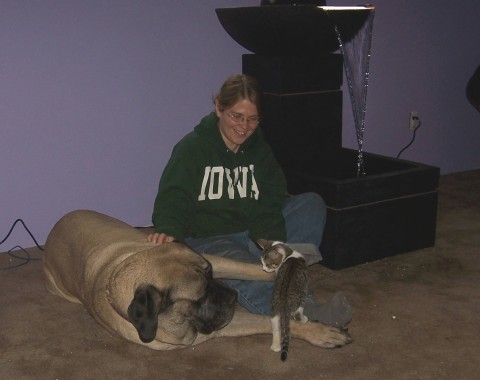
Spoon, Spike the kitten, and me in the tranquility room.
One day, Spoony managed to get back into the Tranquility Room while Dave and I were out shopping. When we returned, we found kittens – mercifully unharmed – scattered throughout the house (the non-kitten-friendly dogs were all kenneled when we were gone). Unfortunately, one kitten — a little tabby named Taz — was nowhere to be found. We’d turned the house upside down when Pop emerged from his room.
“You missing someone?” he asked. When we told him that we were, indeed, one kitten short, he gestured us into his room.
There, sleeping cozily on top of Lucy’s gargantuan belly, was Taz.
“She brought him in while I was washing up,” Pop said. “I didn’t know where you wanted him, and he didn’t seem too concerned, so I just left ‘em.”
We never again doubted Lucy’s good intentions when it came to the babies she so desperately seemed to want to mother.
◊◊◊◊◊
By now it’s dusk. We’ve had our dinner and our walk, and Killian and Adia have stopped their spatting and are curled up together on the day-bed. I ask what story we should tell next.
“The move, of course,” Adia says, as if I’m a little daft.
“Yeah – the move,” Killian agrees. “That’s a good story. We can tell about getting the bus and how Dave ripped out all the seats so we could fit our fridge, and what happened to the cows, and the school and – ”
“You’ll spoil it if you tell it all now,” Adie says indignantly. “Later, we’ll tell about the move.”
I agree: the move is the next story.
Jen Blood is author of the USA Today-bestselling Erin Solomon mysteries and the newly released The Darkest Thread, the first novel in the Flint K-9 Search and Rescue Mysteries. You can learn more about Jen and her work at www.jenblood.com.

